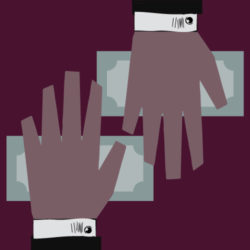Gaza’s journalists, caught between bombs and disinformation
More than 11,000 people have been killed in about six weeks, as Israel bombs the Gaza Strip in its bid to wipe out Hamas. The numbers are beginning to have a numbing effect. And that may be precisely the point. “We Are Not Numbers” is a website that publishes stories largely written by young people who live in Gaza. The numbers, the writers say, “don’t convey the daily personal struggles and triumphs, the tears and the laughter, and the aspirations that are so universal that if it weren’t for the context they would immediately resonate with virtually everyone.”
Inevitably now, these stories are about death and displacement. Last month, Mahmoud al-Naouq, the 25-year-old brother of “We Are Not Numbers” co-founder Ahmed al-Naouq, was killed, along with several other members of his family. Mahmoud had just received a scholarship to go to graduate school in Australia. Al-Naouq is hardly the only local journalist in mourning. A correspondent for Al Jazeera was on the air when he heard that his wife, 7-year-old daughter, teenage son and baby grandson had all been killed in an Israeli airstrike. He is filmed, in tears, standing over his dead son’s body. “I suppose I should thank God,” he says, “that at least some of my family survived.”
Among the thousands of people who have been killed in Gaza are dozens of journalists. The Committee to Protect Journalists says 42 journalists and media workers have been killed (as of Tuesday, November 14) during this conflict, 37 of them Palestinian. The CPJ says these numbers are unprecedented since it began keeping such records in 1992. Just as Israel is paying little heed to civilian casualties in Gaza in the course of its stated mission to obliterate Hamas, it refuses to take responsibility for killing journalists. The Israeli Defense Forces told major news wires including Reuters and Agence France-Presse that it could not guarantee the safety of their employees in Gaza. In fact, not only are authorities in Israel not guaranteeing the safety of journalists, they have been conflating journalists with terrorists.
Israeli government officials have openly claimed that Gazan journalists are siding with Hamas and are therefore legitimate targets. On X, Benny Gantz, a former defense minister of Israel and currently part of the country’s wartime cabinet, posted that journalists who knew “about the massacre, and still chose to stand as idle bystanders while children were slaughtered — are no different than terrorists and should be treated as such.”
Based on scanty and circumstantial evidence, a pro-Israel media watchdog accused photojournalists who have worked for the wire services, as well as The New York Times and CNN among others, of having prior knowledge of the October 7 attacks. One of these journalists, Hassan Eslaiah, has found himself singled out. In 2020, he posted a photograph of him being kissed by a Hamas leader believed to have masterminded the October 7 attacks. Eslaiah also took some of the earliest photographs of the Hamas attacks. Both the Associated Press and CNN had used Eslaiah’s photographs but now said they would no longer work with him. “While we have not at this time found reason to doubt the journalistic accuracy of the work he has done for us, we have decided to suspend all ties with him,” said CNN in a statement.
What evidence Israel has to denigrate and doubt the integrity of the journalists they threaten may be unclear. But what is clear is that it will be left to the consciences of individual journalists to stick up for their Gazan colleagues.
About 900 journalists have signed an open letter dated November 9 that declares their support for journalists in Gaza. “Without them, many of the horrors on the ground would remain invisible.” The letter writers, “a group of U.S.-based reporters at both local and national newsrooms,” note that “taken with a decades-long pattern of lethally targeting journalists, Israel’s actions show wide scale suppression of speech.” This suppression is abetted, the writers contend, by “Western newsrooms accountable for dehumanizing rhetoric that has served to justify ethnic cleansing of Palestinians.”
In 1982, Palestinian American intellectual Edward Said wrote about “those who go on sanctimoniously about terrorism and are silent when it comes to Israel’s almost apocalyptic state terrorism.” Over 40 years later, almost nothing has changed when it comes to the mainstream Western media’s coverage of the conflict. As Israel flattens Gaza, the Western media ties itself in semantic knots — insisting, for instance, on using phrases such as “Hamas-run health ministry” to shroud casualty figures in doubt or worse, to do Israel’s job for it by associating all residents of Gaza with terrorism. It is, as the letter writers put it, “journalistic malpractice” to fail or refuse to tell the whole story. The people who are best able to tell the story and whose voices are so rarely prioritized are in Gaza, silenced by both Israeli brutality and Western media outlets still unable to shake their biases and narrative tropes.
Ukraine’s forgotten children
Russia’s notorious children’s rights commissioner, Maria Lvova-Belova, has been inviting foreign journalists from the United States, Finland and Japan to visit camps in which thousands — possibly hundreds of thousands — of abducted Ukrainian children are held. In March, the International Criminal Court put a warrant out for Lvova-Belova’s arrest, alongside that of her boss, Vladimir Putin, for unlawful deportation of children, a war crime. But this has yet to stop them. And now they’re putting the children on display. A documentary that recently aired on British television showed how the children were often duped into thinking they were being taken to a holiday camp and then subjected to “re-education,” including being told to speak only Russian and singing patriotic Russian songs in front of inspectors.
Attempts to portray life at these camps as idyllic will strike most viewers as obvious propaganda, but Lvova-Belova is not giving up trying to persuade us otherwise. In social media posts — which my colleague Ivan Makridin translated for me — she recently described the meeting between the journalists and the children as a “mentorship” opportunity. The young Ukrainians apparently asked their foreign visitors what they thought of the camp. “I like it very much,” Lvova-Belova quotes a Japanese journalist as saying. “I think your faces are all beautiful, cheerful and happy.”
When you know you are meeting children who are being held captive and who are not speaking freely while the press officer is in the room, why go through with it? While I understand the journalistic impulse of wanting to see the camps and meet the children, I find the ethics of agreeing to go on a guided tour dubious. Especially when Lvova-Belova is going to twist your presence into “proof” that these children are somehow better off at a camp in Russia than with their families. Back in May, Coda’s editor-in-chief Natalia Antelava criticized Vice for agreeing to interview Lvova-Belova and failing to hold her to account. Instead, Antelava wrote, Vice gave Lvova-Belova and the Kremlin “a platform to spin and legitimize their narrative.” This latest invitation to foreign journalists looks like more of the same.
India’s creepy deep fakes
Last week, a Bollywood film star’s face was attached to another woman’s body in a salacious deep fake that went viral. It caused outrage, at least in part because of how convincing the video was and how easy it now seemed to use generative artificial intelligence to spread mischievous misinformation. Celebrities, the government and national newspaper editors made public calls for draft legislation that would punish the creators of fake videos. But that’s easier said than done — defining “fakeness” under the law is harder than it sounds — and any law attempting to rein in this kind of material could pave the way for government overreach. It could also add fuel to the Indian government’s case against end-to-end encryption, since this kind of technology could help mask the identities of people creating deep fakes. If this should come to pass, the pitfalls for privacy and opportunities for mass surveillance will be significant, and could have much more profound effect on many more millions of people than a handful of salacious videos have had.
WHAT WE’RE READING:
- I enjoyed this lengthy meander through the origins of machine-generated text by the academic Richard Hughes Gibson. In the 1960s, Gibson reveals, the author Italo Calvino was already prepared to concede that the “literature machine” might match or outdo the human writer. What the machine couldn’t do, though, was replicate the reader and the particularity the reader brings to the text — the sudden associations and minor epiphanies. “Calvino,” writes Gibson, “anticipated the urgent question of our time: Who will attend to the machines’ writing?”
- The International Olympic Committee is hopping mad. A slick four-part Netflix documentary, narrated by Tom Cruise no less, reveals that corruption within the IOC is destroying the Olympics. Except, the “documentary” is fake: Cruise’s voiceover is AI generated and no such program can be found on Netflix. The nine-minute episodes were uploaded onto a largely Russian language-dominated Telegram channel, which unlike YouTube has not taken the videos down. Is it a coincidence that they started emerging after the IOC banned the Russian Olympic Committee for its decision last month to recognize regional federations in occupied regions such as Kherson and Donetsk? This inquiring mind wants to know.







